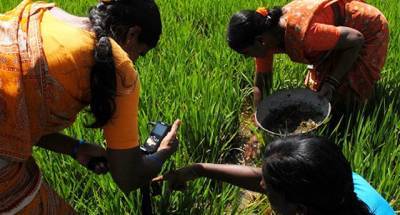HYDERABAD, 3 May 2020: Data with the Indian government suggests that agromet advisories have the potential to yield benefits worth over US $430 billion for India’s 90 million agricultural households.
About a quarter of these access some form of advisories and benefit from it, though this still is well short of the total ‘risk management’ benefits that can accrue if all farm households were to access advisories.
What can be done to benefit all farm households? The research community believes the response lies in next generation of advisories—improved significantly in scale, content, context and timeliness by taking advantage of advances in climate science, big data analytics, digital communication and agriculture itself.
The need for revising or renewing advisory systems is ever persistent given the multitude of changes that affect agriculture. In response to this demand for constant improvement, India’s agromet advisory system, operational since 1976 and considered one of the longest running in the world, has undergone many changes to be what it is today. What should tomorrow’s agromet advisory system (AAS) look like?
To answer this question, climate scientists, agricultural researchers, farmer-participatory experts and other specialists from the Indian Institute of Tropical Meteorology (IITM), India Meteorological Department (IMD); CGIAR institutions – ICRISAT, CIMMYT and World Fish; University of Reading, Watershed Organization Trust, GEAG and Regional Integrated Multi-Hazard Early Warning System for Africa and Asia (RIMES) gathered in February at a special session on the sidelines of the International Conference on Climate Services in Pune, India, to assess the existing system and ponder a likely ‘Nextgen’ AAS.
Ensuing discussions were three-pronged – data acquisition from multiple platforms, generating content for dissemination and its delivery with feedback.
Data acquisition
The group felt that there is a data cache, including observational network data and forecasts, not easily accessible and readily interpretable. In addition to suggesting making the data available to stakeholders in user-accessible and usable digital formats, the group argued the need for regular capacity building to enhance the use of such data. About forecasts, the discussion group agreed that forecasts have to be provided with different lead times—now casting, short range, medium range, extended and seasonal. Scaling-out of the Indo-Gangetic Plain fog forecast work to rest of India was also suggested. The availability of remote-sensing data and its use was emphasized.
Generating content
Besides regular in-season advisories, the group suggested that a Nextgen AAS accommodate pre-season advisories based on long-range seasonal and four-week forecasts for two groups-farmers, and state and input suppliers. The advisory for state and input suppliers can deal with crops and varietal choices depending on season forecasts and area likely to be covered at district level to determine seed, fertilizer and other input requirements.
For farmers, pre-season advisories with a lead time of at least 15 days can help understand the seasonal conditions forecast, crop options with associated risk, and land allocation suggestions for different crops considering the risk and profit potential. These could be accompanied by agronomic management tips, as well as input and investment guidelines.
The in-season advisories have to be highly location specific (block level) if they are to support decision-making for field operations. Considering the crucial role planting related decisions make to yield outcomes, the group stressed the need for best support for planting decision-making. Timing of intercultural operations to conserve soil moisture and economic use of fertilizers are two other areas that require attention, the group felt.
Information on pest and diseases in existing systems can be improved with advances in real time monitoring technology, like remote sensing and IoTs which enable hyperlocal weather measurements and crop surveillance.
Mobile based crop health diagnostic applications (like plantix) can help crowdsource critical data on the spread of pests and diseases. Post-harvest advisories are also essential as farmers lack storage facilities and require guidance.
Inter-seasonal dry spells, extreme weather events and other uncertainties need to be factored in the advisories. Alerts for such events and mitigation strategies should be presented.
Information delivery and feedback
In recent years, the development of digital platforms have shown ways of effective information delivery. The work done on Meghdoot and Mausam, developed by IITM, IMD and ICRISAT can be built upon.
Clearly, the group favored moving away from the traditional delivery systems to smartphone apps and social media, given the spread of internet and the capabilities of these media to accommodate data, M&E and feedback. That apart, when delivered at community level through these media, farmer discussions and information sharing can follow.
The group also suggested gamified advisories for auto-generation of messages; it was felt that human intervention should be restricted to verification and validating content. For end-users who desire more information, longer versions of the advisories can be made available digitally.
More importantly, the members of the group echoed that timing of in-season advisories is crucial, taking into account the lifecycle of a crop or enterprise. Advisories should help narrow decision choices and have market implications, leading to high impact in terms costs or benefits.
To trial a Nextgen system, the group has suggested selecting five Agromet Field Units (AMFU) where the framework and the software can be piloted.
About the authors:
Dr Karuturi Rao,
Honorary Fellow at ICRISAT
Dr Anthony Whitbread,
Research Program Director – Innovation Systems for the Drylands (ISD) and Country Representative – Tanzania, ICRISAT
Dr Ramaraj Palanisamy,
Associate Scientist, ISD, ICRISAT
Source: ICRISAT




















